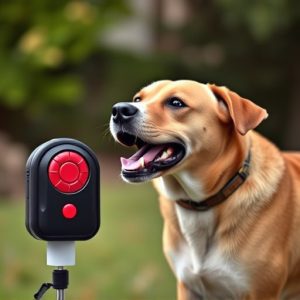Mastering Bark Control: Optimal Vibration Ranges for Effective Dog Repellents
Bark control devices using ultrasonic sounds or vibration technology offer humane and effective solu…….
Bark control devices using ultrasonic sounds or vibration technology offer humane and effective solutions for excessive dog barking. Advanced models allow users to adjust sound intensity and vibration levels, catering to pet sensitivities and behaviors. The optimal vibration settings balance effectiveness and humane treatment, with lower frequencies for indoor use and higher for outdoor areas. Devices should be strategically placed and activated to gently alert dogs through vibrations when they bark, adjusting settings as behavior improves. These devices have proven successful in various settings, from homes to public spaces, complementing positive reinforcement training for comprehensive bark control.
“Discover the revolutionary power of bark control devices, specifically designed to address excessive dog barking. This comprehensive guide explores the inner workings of these innovative solutions, delving into the science behind vibration settings as a humane deterrent.
Learn how to choose the optimal vibration range for your pet’s needs and navigate the setup process effectively. From real-world applications to inspiring success stories, this article covers everything you need to know about the best vibration settings for dog repellent devices, ensuring peaceful coexistence with your furry friend.”
- Understanding Bark Control Devices: How They Work
- The Science Behind Vibration Settings for Dog Repellents
- Factors to Consider When Choosing the Best Vibration Range
- Step-by-Step Guide: Setting Up and Using Your Dog Repellent Device
- Real-World Applications: Success Stories and Tips
Understanding Bark Control Devices: How They Work
Bark control devices are innovative solutions designed to address excessive dog barking, offering a humane and effective alternative to traditional punishment methods. These devices work by emitting a sound or vibration that disrupts the barking pattern without causing harm to the animal. The most advanced models feature multiple ranges, allowing users to adjust the sensitivity and intensity of the response based on their specific needs and their dog’s behavior.
When activated, these devices typically use either ultrasonic sounds or vibrations to deter barking. Ultrasonic devices emit high-frequency sound waves that are inaudible to humans but irritating to dogs. Vibration-based models, on the other hand, use gentle yet effective vibrations to disrupt the barking cycle. The best vibration settings for a dog repellent device should be adjustable, allowing users to fine-tune the intensity to match their dog’s sensitivity and the severity of the barking issue. This customization ensures effectiveness without causing unnecessary distress to the pet.
The Science Behind Vibration Settings for Dog Repellents
The effectiveness of a dog repellent device often hinges on its vibration settings, which are designed to mimic natural deterrents and create an unpleasant sensory experience for the canine. When a dog detects these subtle vibrations, it triggers their innate avoidance responses due to past experiences or natural instincts. The key lies in finding the optimal frequency and intensity that resonates with these sensitivities without causing harm or distress.
Best Vibration Settings Dog Repellent Device typically offers multiple ranges catering to different scenarios and dog behaviors. For instance, lower frequencies can disrupt a dog’s communication signals, while higher ones may stimulate their nervous system. Adjusting these settings allows users to tailor the device’s response according to the environment, whether it’s a gentle nudge for persistent barkers or a stronger signal for aggressive behavior. This versatility ensures that owners can find the most effective and humane solution for their furry companions.
Factors to Consider When Choosing the Best Vibration Range
When selecting a bark control device with multiple vibration ranges, understanding what works best for your situation is key. The best vibration settings dog repellent device should cater to both indoor and outdoor environments, offering adjustable intensity levels tailored for different scenarios. Consider factors like the size of your space, proximity to neighbors, and sensitivity of your pet to determine the ideal range.
For instance, a stronger vibration might be suitable for large outdoor areas where barking can travel far, while a gentler setting is better for indoor spaces or closer quarters to avoid disturbing others. Remember, the goal is to find the right balance—not too strong to cause discomfort or stress but enough to deter excessive barking effectively.
Step-by-Step Guide: Setting Up and Using Your Dog Repellent Device
Setting up and using a dog repellent device with multiple range options is straightforward. Start by selecting the best vibration settings tailored to your situation. These devices often offer various intensity levels, allowing you to choose a gentle reminder or a stronger deterrent depending on your needs. For indoor use, opt for lower frequencies that are inaudible to humans but effective for dogs. Outdoor setups can benefit from higher frequencies, ensuring comfort without disturbing neighbors.
Next, place the device where it’s most needed. This could be at entry points, dog run boundaries, or anywhere persistent barking occurs. Ensure it’s securely mounted or staked to prevent tipping over. With the device powered on and set to your preferred vibration level, you’re ready. When your dog barks excessively, the vibrations will gently alert them without causing harm. Adjust settings as needed based on behavioral changes, ensuring consistent results in training your pet.
Real-World Applications: Success Stories and Tips
In real-world applications, bark control devices with multiple ranges have proven to be highly effective in various settings, from homes and gardens to public parks and commercial properties. Success stories abound where these devices have successfully reduced unwanted dog barking, enhancing quality of life for both residents and nearby neighbors. For instance, homeowners struggling with persistent barking from their neighbor’s dog have reported significant improvements after deploying a bark control device with adjustable vibration settings.
When using such devices, it’s crucial to select the best vibration settings tailored to the specific situation. For outdoor spaces like parks or public areas, setting the vibration level slightly higher can help deter barking without causing distress to nearby pets or people. Additionally, consistent use and proper placement are key to achieving optimal results. Regular training and positive reinforcement for dogs can complement these devices, making them part of a comprehensive approach to bark control that fosters harmony in diverse environments.
When it comes to training your canine companion, a bark control device equipped with adjustable vibration ranges can be an effective tool. By understanding the science behind these devices and selecting the optimal vibration settings for your dog’s unique needs, you can find the perfect balance between comfort and correction. With proper use, this innovative technology offers real-world applications that lead to successful behavior modification, ensuring a quieter and happier home environment for both pets and owners alike. Remember, finding the best vibration range for your dog repellent device is key to achieving desired results without causing distress.


